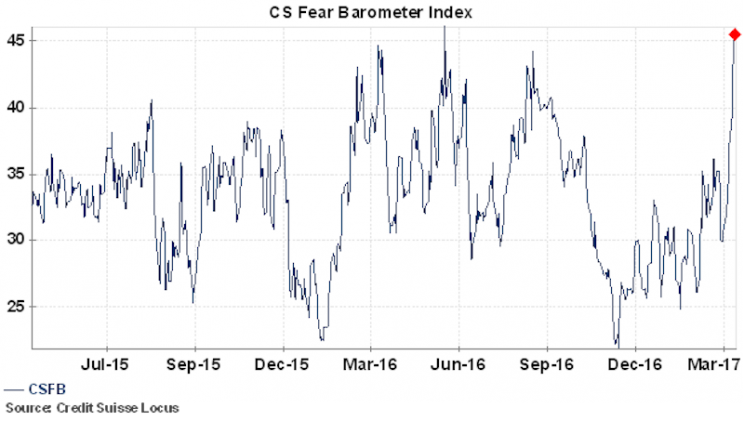By one measure, investors have almost never been this nervous about stocks

Stock market investors have rarely ever been this skittish.
As measured by Credit Suisse’s in-house fear barometer, investors haven’t been as concerned as they are right now since just before Brexit, when the firm’s gauge hit an all-time high.
This reading follows data out last month which showed investor concerns about a market crash reaching levels not seen since 2009.
And while the VIX, an index which measures future expected volatility in the stock market, has been on the rise in recent days, the mood among many investors remains one of agreeing that things are quiet, too quiet.
Which brings us to the circular logical gift that is market volatility: a lot of volatility means things are bad, which is a reason to worry; very little volatility means people aren’t worried enough about things being bad in the future.
Fear rising
Credit Suisse’s gauge basically measures how much it costs to be protected against a major drop in stock prices.
Or, as Credit Suisse’s Mandy Xu explains in more technical terms, “[The fear barometer] is a measure of 3M skew in S&P. It is calculated by selling a 10% [out-of-the-money] call on the S&P and using that premium to purchase downside protection. The level of the index indicates the [percent out-of-the-money] strike of the put that makes the strategy net zero cost. A high CSFB reading signals high cost of protection relative to upside calls.”
What’s notable, however, is that the current rise in the fear barometer is related to investors getting more bearish on potential upside for the stock market than they are explicitly worried about a drop. And so the rise in this index indicates not so much the increasing cost of being protected against a drop in stocks, but the declining costs of hedging out potential rises in the stock market.

Notably, this is exactly the opposite of what happened after the election.
In the months after Donald Trump’s win, stocks surged as business, consumer, and investor enthusiasm shot higher simultaneously. As a result, Credit Suisse’s fear barometer index fell because the cost of protecting against a drop in stocks fell sharply relative to how much it cost to bet against a further rise in the market.
Now, with investor enthusiasm — at least as measured by the options markets — seeming to wane, it’s gotten far more expensive to be protected against a drop in market. But mostly because investors don’t think it’s likely the market rises further from here.
“If you break down the increase in S&P skew, you can see that while put demand has certainly increased over the past week, the biggest mover actually comes from the call-side,” Xu writes
“Falling call skew indicates investors see less potential for market upside going forward, perhaps in recognition of the increased macro and political headwinds… This marks a complete reversal of the skew dynamic we had been seeing since the US election where strong call demand lifted call-skew to record highs.”
—
Myles Udland is a writer at Yahoo Finance. Follow him on Twitter @MylesUdland
Read more from Myles here:

